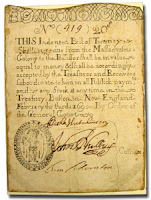 On 3rd February 1690, the Massachusetts Bay Colony legislature issued $40,000 worth of Bills of Credit. The British King authorised the Massachusetts General Court to issue these promissory notes to pay the army it had raised to fight against the French in Canada during King William’s War, since it was short of official coinage at that time. Recipients of the notes could later redeem them for coins to the value of the issued note.
On 3rd February 1690, the Massachusetts Bay Colony legislature issued $40,000 worth of Bills of Credit. The British King authorised the Massachusetts General Court to issue these promissory notes to pay the army it had raised to fight against the French in Canada during King William’s War, since it was short of official coinage at that time. Recipients of the notes could later redeem them for coins to the value of the issued note.
Each note read:
This indented Bill of […] Shillings due from the Massachusetts Colony to the Possessor shall be in value equal to money and shall be accordingly accepted by the Treasurer and Receiver Subordinates to him in all Public payments and for any stock at any time in the Treasury – New England, February the third, 1690. By order of the General Court.
The notes proved a great success, soon entering general circulation.
The legislators spotted the potential of paper money and started issuing more notes not only during emergencies but also to cover the cost of general administration. The other New England colonies soon followed suit, issuing their own banknotes with mixed results. A shortage of gold and silver meant that the notes were rarely redeemed; yet, the authorities continued to print more notes resulting in their devaluation.


